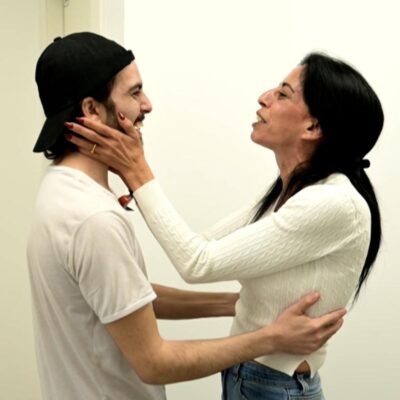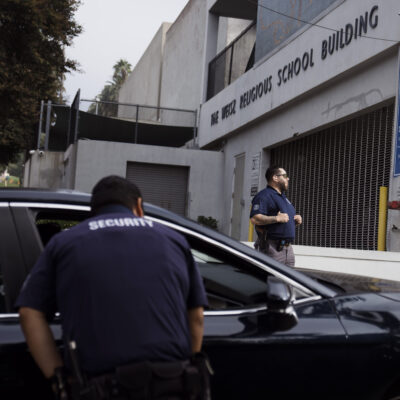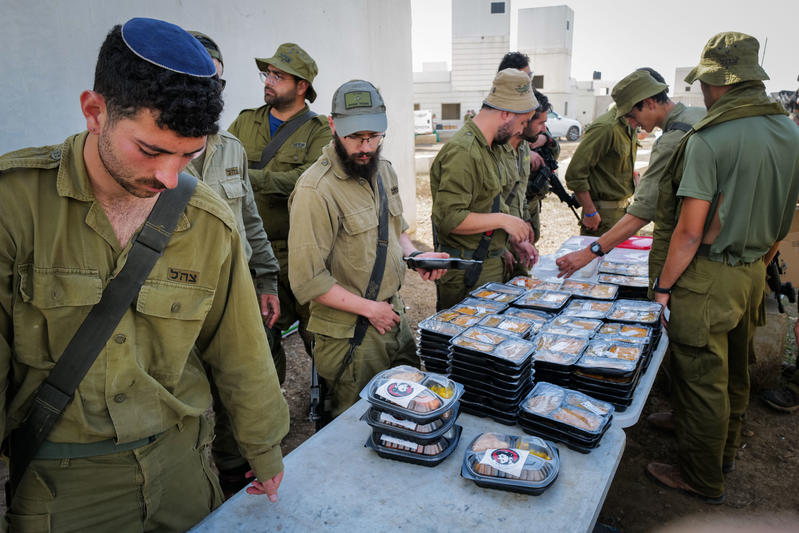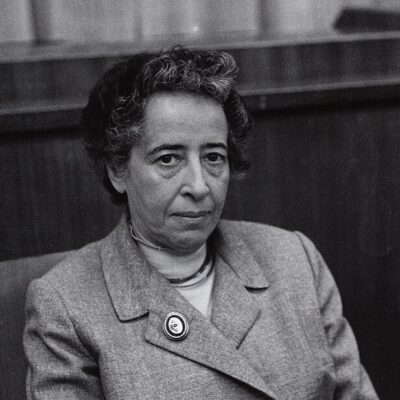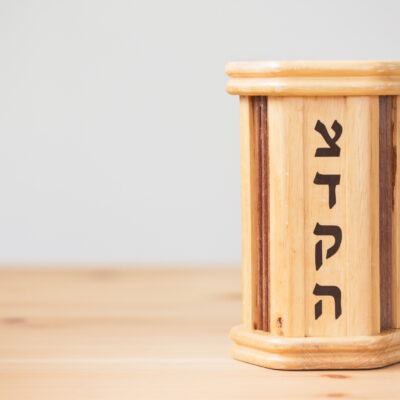Jewish Literacy Empowers Jewish Action
 by Dr. Marc Kramer
by Dr. Marc Kramer
There is a famous argument in the Talmud over which takes precedence, Jewish learning or Jewish action:
- Rabbi Tarfon and some elders were reclining in an upper chamber in the house of Nitza in Lod when this question came up: Which is greater, study or action? Rabbi Tarfon spoke up and said: Action is greater. Rabbi Akiva spoke up and said: Study is greater. The others then spoke up and said: Study is greater because it leads to action. (Kiddushin 40b)
Learning is great because it leads to action – this is the consensus reached. Action without learning is blind, impulsive; learning without action is impotent. Only when learning and action inform each other are both nourished and replenished, creative and dynamic. As modern research consistently shows, “service learning” – the alignment of action and study – creates a hybrid that is much more effective than what service and learning can accomplish separately.
Previously, I argued for the importance of Jewish literacy as providing a richer and more powerful framework for discussion of the mission of Jewish day schools, compared with the prevalent emphasis on Jewish identity (see: Beyond Identity: Day Schools Deliver Jewish Literacy). Here I’d like to expand upon that idea to explore ways that Jewish literacy can lead to new, creative forms of Jewish action, through embracing contemporary modes of learning.
Jewish education has historically put great value in knowledge acquisition. Talmud Torah keneged kulam – Jewish learning is as valuable as a host of other mitzvot combined. In a technological reality that literally puts virtually everything that can be known into the palm of your hand, this traditional memory-based learning model is becoming less relevant. What emerges instead is the great opportunity to emphasize the application of knowledge, ideally in ways that foster collaboration, draw on creativity, and bring about positive change and lasting good.
Thanks in large part to the enormous and never-ending expansion of technological powers, we live in a cultural moment of DIY – the Age of Google – when it feels like everyone can or soon will be able to make anything or solve any problem and the horizon of what is possible for a few friends with laptops to accomplish roars closer by the second. With great enthusiasm and anxiety, educators are looking to adapt schools to these emerging trends and enable students to have the tools to thrive in this dizzying environment. The term “21st century” has become an adjective for “learning.” A host of new prophets, among them Tony Wagner and Daniel Pink, and organization-gurus such as Edutopia, IDEO and p21.org have arisen to lead us into this Gan Eden or Novus Ordo Seclorum.
For some time, Jewish day schools have been finding inspiration in these developments, turning learning into action by re-envisioning the look and feel of Jewish education. Some, like the Hillel Academy of Tampa, have hired architects to redesign spaces, replacing “classrooms” with “21st century learning spaces” by adding movable glass walls and modular furniture. Certainly, the growth of positions in experiential (or “informal”) education at day schools, along with the rise of several recent degree programs, aligns with the zeitgeist. Schools across the denominations, including many RAVSAK schools and modern Orthodox ones such as Frisch and DAT, are looking to implement Project-Based Learning as a vehicle to achieve these new goals, while other schools experiment with robotics and STEM/STEAM programs to similar effect. The Jewish Day School of Metropolitan Seattle is planning a yearlong Maker Faire starting this fall. In different ways, Inquiry-based learning, Jewish gardening/farming/nature programs, several new high-tech schools and Andrea Rose Cheatham Kasper’s vision for a hands-on Jewish day school all testify to a healthy drive for Jewish day schools to become laboratories of innovative Jewish action.
All of these initiatives have in common the desire to take learning beyond the classroom in an extended and ongoing way, to apply Dewey’s ideas of authentic education through the means and vehicles available in the contemporary world. In day schools, this imperative applies to Jewish learning in particular, transforming a discipline that had always been heavily text-bound into one that inspires students to find relevance and application through engagement with the larger society. Inspired and informed by the new entrepreneurial spirit taking hold in Jewish society – whether in areas of social action, nonprofit innovation or cutting-edge design – Jewish studies is being transformed, thanks in no small part to the collaborative, innovative model of JEDLAB and the planful social media conversations of Darim Online, into an incubator of Jewish creative endeavor.
Day schools now encourage students to borrow and sow ideas profligately and see what they can reap. Israel serves as a shining example in this work; schools look to Israel as they bring the innovation and collaboration of the “start-up nation” to day school students, whether through collaborations with Israeli schools and organizations, or by hosting speakers from the Israeli tech sector. Authentic assessment is no longer about taking a test or writing on essay demonstrating that that a student has memorized Rambam’s ladder of tzedakah; instead, it’s setting up teams of students to create an initiative that puts Rambam’s ideas into action, benefitting many people in a way that empowers them to “pay it forward.” The task is to enable students to mine Jewish sacred sources to find inspiration and guidance for contemporary challenges, both in Jewish society and the larger world.
Our programs at RAVSAK are inspired by and built upon this notion that Jewish texts can, and indeed must, step off the page and out into the world. For students, the Moot Beit Din challenges them to apply halakhic sources to cutting-edge contemporary issues; the Judaic Art Contest brings out vibrant, creative responses inspired by traditional Jewish sources; participants in our Hebrew Poetry Contest study the rich history of Hebrew writing as they craft Hebrew poems of their own. For school leaders, Project Sulam has for over a decade encouraged administrators to derive values and draw creative insights for their work through study of sacred texts; Sulam 2.0, a program for board members started this year, empowers lay volunteers to grind a Jewish lens on leadership through their creative encounter with Jewish sources.
Another episode from the Talmud demonstrates that the interweaving of action and learning is a critical ideal embedded in our sacred texts (Ketubot 103b). Rabbi Hanina and Rabbi Hiyya were study partners, and when their arguments waxed hot they would dispute whose approach was greater. Rabbi Hanina’s intellectual prowess was so acute, he could restore the entire Torah and its traditions should they be forgotten. What could Rabbi Hiyya hold up to that? He used to sow flax, from which he made nets, which trapped deer, whose meat he would feed to orphans and whose skin he would process into Torah scrolls, which he would then use to teach children in towns lacking teachers. The Talmud concludes with the verdict of Rabbi Yehudah HaNassi: “How great are the works of Hiyya!”
The Internet has rendered Rabbi Hanina’s impressive skills somewhat less necessary. Day schools today need to cultivate more Hiyyas: Jews inspired by Jewish learning and wisdom, with the initiative to weave their own nets – networks, “Webs” – to sift through the enormous world of ideas and resources available and trap the ones best-suited to their vision. We need to transform the traditional Jewish learning paradigm into one that better aligns with 21st century thinking about education, and at the same time, honors the sacredness of Jewish study. Our task is finding new ways to apply the ancient Jewish insight that “study leads to action.”
Dr. Marc Kramer is Executive Director at RAVSAK.

 Add EJP on Google
Add EJP on Google